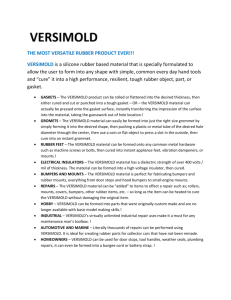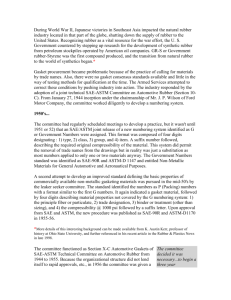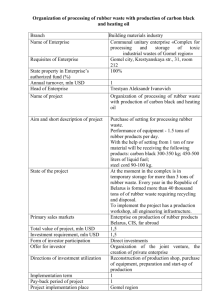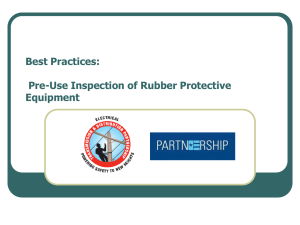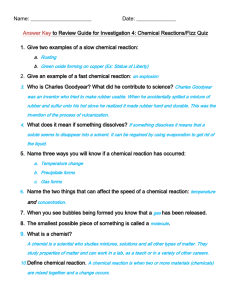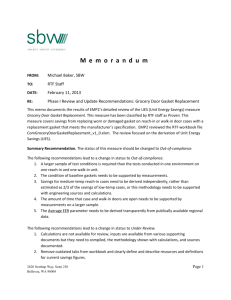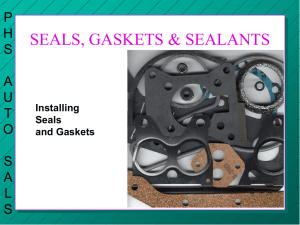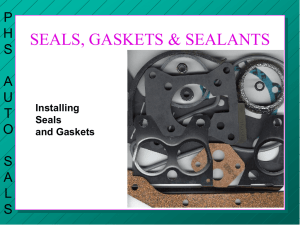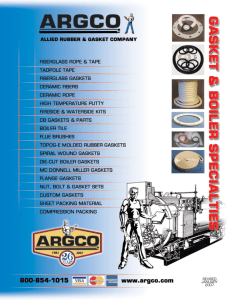Globe Composite Solutions, Ltd
advertisement
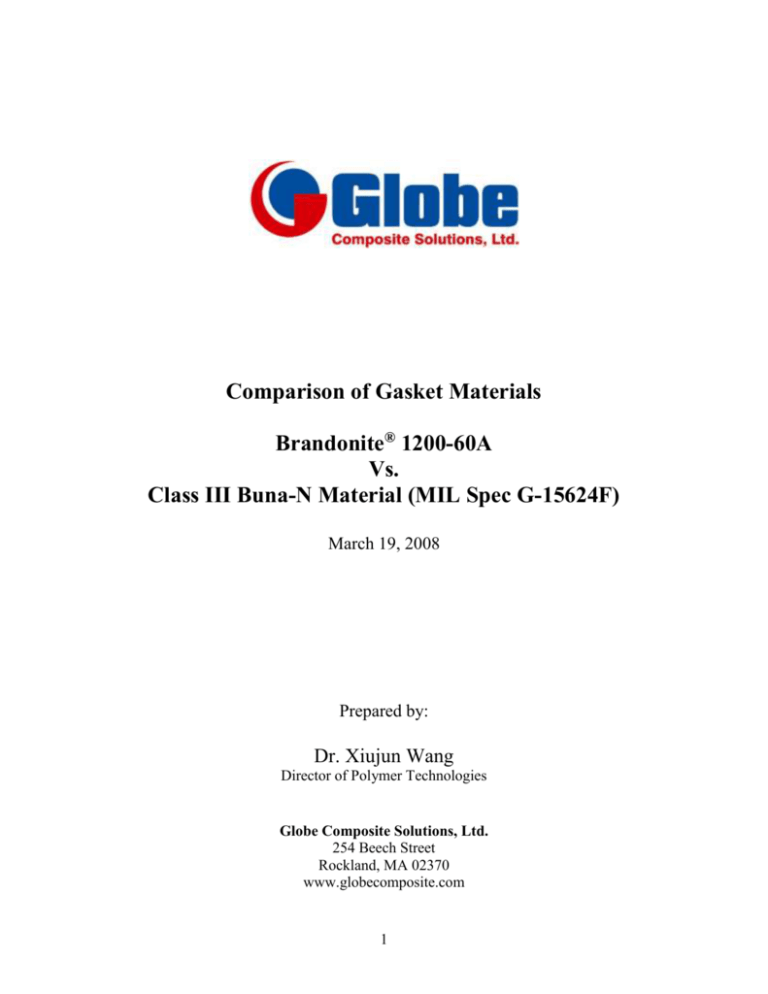
Comparison of Gasket Materials Brandonite® 1200-60A Vs. Class III Buna-N Material (MIL Spec G-15624F) March 19, 2008 Prepared by: Dr. Xiujun Wang Director of Polymer Technologies Globe Composite Solutions, Ltd. 254 Beech Street Rockland, MA 02370 www.globecomposite.com 1 I. Executive Summary Globe Composite Solutions, Ltd. (GCS) manufactures 92-inch diameter gaskets for missile tube muzzle hatch seals aboard US nuclear submarines. These gaskets are made with Brandonite®1200-60A, a high performance polyurethane compound material designed to replace previously specified Class III Type Buna N material (MIL Spec. G15624F). Over the past ten years, the performance of Brandonite®1200-60A material has been flawless: no gasket made with Brandonite®1200-60A material has failed in service due to physical or mechanical failure. Brandonite®1200-60A is a liquid castable material which combines the properties of high tensile strength and elongation with outstanding elasticity and excellent resistance to seawater, oils, chemicals and UV degradation. Additionally, Brandonite®1200-60A tensile strength is 100% greater, weighs 23% less and has similar elongation, Shore hardness and compression set properties as Class III Type Buna N. II. Background In the mid-1990s, there was an increase in the incidence of fraying and/or extrusion damage to the edges of missile tube muzzle hatch gaskets with the Ohio-class SSBN nuclear submarine fleet. This was a major concern since there was a high incidence of failure which caused leaking or flooding inside Trident missile tubes. At that time, the gaskets were manufactured using Mil-G-15624F Type III Buna-N rubber material (copolymer of butadiene-styrene). Sixty-four samples of Mil-G-15624F Type III Buna-N rubber material gaskets were tested and the review found that gaskets made of Mil-G-15624F Type III Buna-N rubber material would degrade over time and failed to meet the physical specifications and dimensional requirements for this application. In pursuit of a resolution to these performance problems, alternative materials were investigated. The choice of a polyurethane-based material was made based on the previous results obtained and the outstanding performance of polyurethane materials used on Seawolf-class submarines. These materials demonstrated excellent survivability in the ocean environment. A series of tests according to the specifications of Mil-G-15624F were conducted and it was concluded that GCS Brandonite®1200-60A high performance polyurethane compound material, then specified as G4317-05, had the combination of properties best suited to resolve failure problems previously observed with Buna-N materials. Since then, GCS, as a primary supplier, has continuously manufactured 92inch diameter polyurethane gaskets for the US Navy and its contractors according to the specifications EB-4224(1) that was established between GCS and General Dynamics Electric Boat. III. Development of Brandonite®1200-60A 2 Brandonite®1200-60A is a polyurethane compound material based on MDI Polyether chemistry. It combines the properties of high tensile strength and elongation, outstanding elasticity, and excellent resistance to seawater, oils, chemicals and UV degradation. Its certification for use in the 92-inch diameter missile tube muzzle hatch seal underwent several major review milestones. Brandonite®1200-60A was initially developed in 1997 by Globe Rubber Works, Inc., whose assets were purchased by GCS in 2004. At that time, six full-sized gaskets made from this material were installed on the Ohio-class submarine SSBN 743 (Louisiana) for sea trials. After minor modifications to the physical dimensions of the gasket, the second set of sea trials demonstrated that hatches fitted with Brandonite®1200-60A gaskets functioned properly. Additionally, the static compression load for these gaskets, as measured in a laboratory fixture, was comparable to that for the original Buna-N gasket. During the sea trials, the gaskets discolored slightly, which is attributable to UV exposure. This caused problems with closing operations of the hatches due to higher compressive loading stiffness. In early 1998, 21 separate UV improvement formulae were incorporated into the compound material formula to improve UV resistance. A test of UV stability was conducted by NMMEL and included completion of Mil-G15624F UV light aging on Brandonite®1200-60A. This test also evaluated: the effects of color pigments and UV inhibitors on physical performance; the effect of reduced gasket height on sealing performance; compatibility of Brandonite®1200-60A with silicone lubricant; and, 48-hour “creep” evaluation requested by NAVSEA 03W14. Additional tests were also performed in the following areas: 1. 2. 3. 4. Hydrostatic Pressure Sealing: Using 7 Inch Diameter Gasket Fixture Static Load vs. Deflection: Using 7 Inch Diameter Gasket Fixture Cyclic Loading: Using 7 Inch Diameter Gasket Fixture ASTM D 624: Tear Strength of Conventional Vulcanized Rubber and Thermoplastic Elastomers 5. ASTM D 471, Rubber properties: Effects of Liquids After conducting these tests, it was concluded that Brandonite®1200-60A polyurethane compound material, incorporated with specific pigments and UV inhibitors, resolved the effects of discoloration and was the most suitable material for solving fraying or extrusion-type damage observed with Buna-N materials. IV. Brandonite®1200-60A Physical Properties GCS Brandonite®1200-60A polyurethane compound material has superior tensile strength and elongation properties when compared with Mil-G-15624F Type III Buna N rubber material. Brandonite®1200-60A also has a significantly lower specific gravity, which is ideal for applications where weight consideration or part handling is a factor. 3 Table 1: Summary of Brandonite®1200-60A Physical Properties Properties Specific Gravity Shore Hardness Young’s Modulus Tensile Strength Elongation at Break Tear Strength Compression Set, Method B Temperature Range ASTM Method ASTM D 792 ASTM D 2240 ASTM D 412 ASTM D 412 ASTM D 412 ASTM D 624 ASTM D 395 Units sp gr 23/23 OC A Scale Psi Psi % lb/inch % Typical Value 1.080 60 172,000 3,000 400 200 30 -20ºF to 200ºF Chemically, Buna-N or Nitrile rubber material is a copolymer of butadiene and acrylonitrile. Acrylonitrile content varies in commercial products from 18% to 48%. As the Nitrile content increases, there is an increased resistance to petroleum-based oils and hydrocarbon fuels, but a decrease in low temperature flexibility. Table 2 lists specifications of Mil-G-15624F Type III Buna-N rubber(2), along with polyurethane compound material Brandonite®1200-60A: Table 2: Mil-G-15624F Type III Buna N Rubber vs. Brandonite®1200-60A Properties Tensile strength, psi minimum Ultimate elongation, percent, minimum Shore A hardness, maximum Specific gravity, maximum Compression set, percent, maximum V. Mil-G-15624F Type III Buna N Rubber 1,550 400 Brandonite® 1200-60A 3,000 400 100% greater Same 50 1.400 30 60 1.080 30 20% harder 22.8% lighter Same Comparison Applications Brandonite®1200-60A is versatile and liquid-castable. It can be used to produce large parts with significantly lower tooling costs when compared to traditional compressionmolded rubber products. GCS processes this material in a unique way which significantly reduces the presence of voids and increases the uniformity of the material as well. Since the material is liquid-castable, one-piece gaskets or seals can be made in virtually any size without the risk of compromising strength along knit-lines or compression zones. Brandonite®1200-60A can be modified to increase or decrease certain physical properties such as tensile strength, rebound, durometer or elongation. It is mold and fungi resistant, 4 which makes the material ideal for marine, agricultural, tropical and water/sewage treatment applications and is available in FDA and non-FDA approved grades. Summarized below is a general comparison of Brandonite®1200-60A with Buna N rubber material: Table 3: Comparison of Brandonite®1200-60A with Buna N Rubber Property Tensile strength Tear Resistance Abrasion Resistance Compression Set Elongation Weight/Specific Gravity Ozone Resistance UV Resistance Hydrolytic Stability Durability/Weathering Low Temperature Resistance Moldability Mold/Fungi Resistance Rebound Durometer Range Higher Temperature Service Diesel/Gasoline Resistance Brandonite® 1200-60A Excellent Outstanding Outstanding Good Excellent Excellent Outstanding Outstanding Excellent Excellent Outstanding Excellent Outstanding Excellent Outstanding Fair Fair/Good A few obvious uses for this material include: VI. Custom-molded shapes Diaphragms Access hatch gaskets and seals Water pump gaskets and seals Storage tanks gaskets and seals Aircraft gaskets and seals Deep-sea gaskets and seals Water/sewage treatment gaskets and seals Marine gaskets and seals Bladders Conclusion 5 Buna N Rubber Good Fair Good Good Good Good Fair Poor Excellent Fair Excellent Fair Poor Good Good Good Outstanding For the last decade, GCS has advanced polyurethane processing technologies and has constantly improved product performance and consistently provides high-quality products. GCS has been able to provide US Navy (and its purchasing departments and contractors) with thousands of 92-inch Brandonite®1200-60A polyurethane gaskets. There has not been a single incident of in-service physical or mechanical failure. This is primarily due to the superior physical properties of Brandonite®1200-60A as well as the processing and molding capabilities of Globe Composite Solutions. VII. Reference 1. “General Requirements for the Procurement of Polyurethane Material”, Specification No. EB-4224 2. “Rubber Gasket Material, 50 Durometer hardness”, Mil-R-15624E 6

